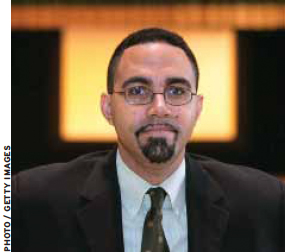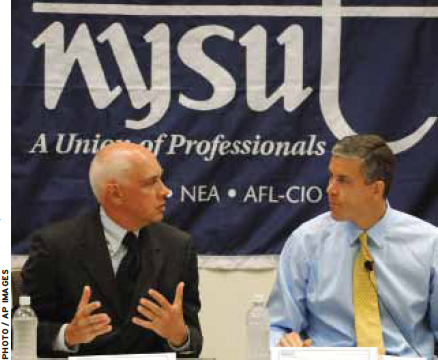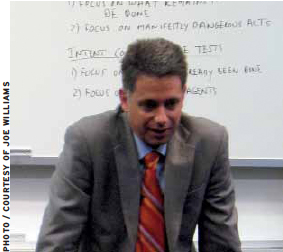News Alert: Black resigning. Press conference at 11.
Dozens of New York City journalists scrambled to get to City Hall, and educators all over the country twittered and tweeted about what had been predictable—and predicted (“Cathie Black will be gone by Easter,” wrote our own Mike Petrilli last December). Meanwhile, some 120 miles to the north, in the 3rd-floor press room of the state Capitol building, veteran radio broadcaster Susan Arbetter was a couple of minutes into her previously scheduled interview with State Board of Regents Chancellor Merryl Tisch. They were chatting about the “surprise” booting of Black, when Arbetter changed the subject.
“There is a rumor,” she said, “that David Steiner, the commissioner of education for New York State, could also be on his way out. I was wondering if you could illuminate us a bit on that?”
The normally unflappable Tisch, the first woman chancellor in New York history, seemed caught off guard. “You know, I have heard a lot about that,” she replied, as if stalling for time. But instead of saying, `just a rumor,’ as most practiced politicos would have, Tisch blurted, “I believe that the Commissioner is exploring his options—”
With all the klieg lights shining on the Bloomberg press conference, it took some time for the news from Albany to get out, but within the hour the Twitter world exploded again, with news that “outdid Mayor Bloomberg’s announcement,” as Philissa Cramer of Gotham Schools wrote, “at least in the department of rattling surprises.”
Rattling surprise, indeed. The sacking of Cathie Black, who had no education experience, surprised like an accident waiting to happen. David Steiner’s leaving rattled people. His elevation to head the state’s education system in October of 2009 had been hailed as a providential pick. With a philosophy degree from Oxford and a doctorate in political science from Harvard, and following stints at the National Endowment for the Arts and Boston University’s School of Education, he was most recently head of Hunter College’s School of Education. Steiner, then just 51, was the education reform world’s dream because he was an insider. And he charged out of the gate, instituting tougher benchmarks for the state’s 3–8 tests, initiating a major effort to write a statewide curriculum, and leading the charge to win a berth in the Race to the Top winner’s circle.
While rumors circulated—Steiner and Tisch didn’t get along, he was pushed out because he had stood up to Bloomberg over the Black appointment—Steiner himself played the resignation, which is to take effect in August of 2011, as if it were part of the plan. The timing of the announcement was not planned, he admits. He had started looking for other work, and it leaked and the leaks “became a flood.” That Tisch confirmed the rumors the same day as Black’s unceremonious sacking was, says Steiner, “bizarre coincidence.”
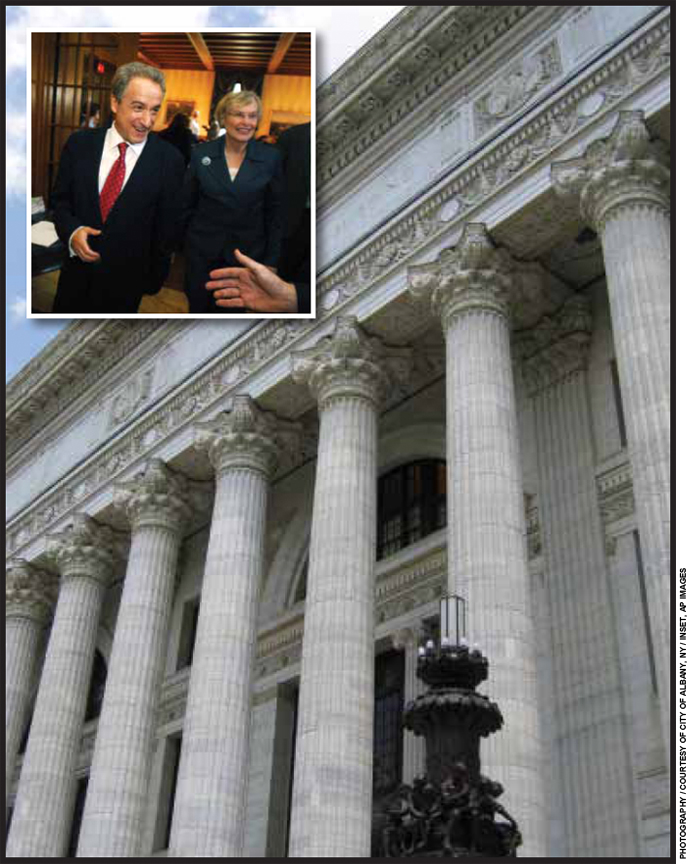
Chapter One Is Written
Saying that Tisch had “plucked” him out of academia to “plant a vision,” to find the funding for it, and to launch a radical reformation of the New York education system, Steiner is satisfied that “we’ve done that…. Chapter one is written. The key to chapter two is grinding implementation. And if you know me, you know that is not what I’m suited for.”
Indeed, Steiner’s chapter one is not a bad start. When I first interviewed him last December, he seemed fully engaged in the grinding implementation. Though he admitted that “the economic conditions on the ground are a huge, huge contextual challenge,” I was less interested in those challenges than in how, in a few short months, he had helped turn the Empire State from a poster child for education indolence, overregulation, overspending, and underperformance—an also-ran in Education Next’s poll of expected RttT winners (see www.educationnext.org/race-to-the-top-round-2-poll)—into an animated system with audacious academic strategies and goals, new (and higher) standards, aggressive timelines for meeting those goals, and, defying the odds, a silver medal and $700 million for finishing second in last summer’s RttT competition.
It is in that story that we can understand the bittersweet feeling of many New York educators that they have lost their leader before they got to the Promised Land.
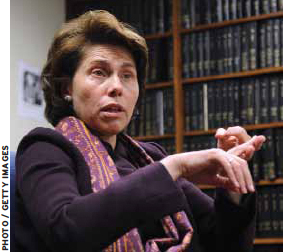
The Genius of Race to the Top
Perhaps it was all just a coincidence, but David Steiner was the right man, in the right place, at the right time. He was savvy enough to understand the importance of Race to the Top and able enough to turn the state’s education energies toward it.
The Washington Post said that the program “helped transform the national discussion on education.”
Education policy maven Rick Hess calls RttT “the centerpiece” of the Obama administration’s education strategy, and “arguably…the most visible and celebrated school reform effort in American history.”
Even David Brooks, conservative columnist for the New York Times, offered that the new federal program was helping prod a “quiet revolution” in American schooling.
Revolutionary, maybe. Quiet, no. A search of the Vocus Media Database, which includes hundreds of traditional media, blog, and social media outlets, found 1169 Race to the Top stories. The School Improvement Grant (SIG) program, initiated at the same time and distributing just about the same amount of money, turned up just 37 mentions.
All this hoopla and RttT was only $4.35 billion (SIG was $3.5 billion), a tiny fraction of the $100 billion in education funds passed out in 2009 as part of the American Recovery and Reinvestment Act (ARRA), and less than 1 percent of the $600 billion spent on K–12 public education in the United States. Inside the Beltway, RttT was known as “Arne’s Slush Fund.”
Unlike NCLB, however, RttT proffered carrots instead of sticks: money for recession-strapped states that promised to implement education reform strategies, specifically, better teacher-evaluation practices, including using student performance as a metric; better teacher training; improved data gathering; and more school turnaround strategies, including more charter schools.
Despite a daunting array of rules for applying—there were 19 different categories that a panel of judges would score on a 500-point scale—states scrambled to join the race. Twenty-three of the applicants (including some strong union states like California, Michigan, and Ohio) passed laws or revised regulations before submitting their applications. Altogether, for round one (though no one knew if there would be a round two), 40 states and the District of Columbia submitted lengthy applications, in January of 2010, chasing millions.
New York State was one of them.
No Place More in Need
Once the shining star of the American public education system, New York has oflate come to represent all that is wrong with American education.
The new governor, Andrew Cuomo, in his first major postinaugural speech, complained, “We spend more money on education than any state in the nation, and we are number 34 in terms of results.” This is a big deal in a state with the third highest enrollment numbers in the country (2.7 million K–12 students, afterCalifornia, with 6 million, and Texas, with 4.6 million).
New York had other problems as well. At risk of bankruptcy and burdened by huge pension obligations, it was already the 4th “most taxed” state in the union (after Hawaii, Connecticut, and Vermont), according to Forbes; it faced a $10 billion deficit; and, as the New York Times put it, had “a divided and perennially dysfunctional Legislature.”
The Revolution Begins
Into the middle of this bog stepped Merryl H. Tisch, a former 1st-grade teacher with an EdD from Teachers College, Columbia University, and a spouse, James Tisch, who heads Loews Corporation and has sometimes appeared on the Forbes 400 list of the richest people in America. Tisch, one of 16 members of the Board of Regents since 1996, was chosen to head the Regents as chancellor in 2009. She had an agenda, the New York Times noted, that included “closing the achievement gap among demographic groups, bolstering career and technical education, and giving equal access to disabled students.” Tisch could, said the paper, be effective pushing that agenda because of “her ascent to chief regent” and “her rank in New York’s ruling class…”
“When my refrigerator is broken,” she once told a group of Catholic educators, “I don’t call the service department. I call the head of GE.”
In the Bloomberg mold, Tisch was a rich reformer at the helm of one of the most intransigent education systems in America.
And one of her first tasks was replacing the longtime commissioner of the New York State Education Department (NYSED), Richard Mills, who retired, on schedule, that June. In late July, education reformers throughout New York were pleasantly surprised to learn that the Regents had selected David Steiner to be the new co
mmissioner. (Truth in advertising: He has contributed to this journal.) Over the years, Steiner quietly built a reputation as a reformer’s reformer, willing to challenge the education system’s multiple vested interests—from the inside.
If there was any doubt that Tisch and Steiner weren’t serious about bringing change to New York’s hidebound public school system, that ended when they tapped John King to be NYSED’s number two. An African American Brooklyn native and product of the city’s public schools with his own Ivy League credentials, King cofounded Roxbury Prep, a successful Boston charter school, and was managing director of Uncommon Schools, which operated a network of 24 charter schools in New York, Massachusetts, and New Jersey when Tisch called him. The two had met in 2000 when they were both in the doctoral program at Teachers College. And King knew Steiner through Teacher U, a teacher training program Steiner launched as a partnership with three high-performing charter management organizations while he was at Hunter.
By the time Steiner and King arrived in Albany, in the fall of 2009, the race for RttT funds was already on. There is some disagreement about how serious New York took the competition at that point. Joe Williams, head of Democrats for Education Reform (DFER), says that “the general consensus from Merryl Tisch and Governor [David] Paterson on down the line was that Chuck Schumer is a powerful Senator—why does New York need to worry? We send our elected officials to Washington to bring home the bacon, so why was this going to be any different?”
Tisch scoffs at that view of things. “Oh, God forbid!” she says. “That is a wild accusation.” She notes that Steiner didn’t arrive until October 1 and King, November 1, with the RttT application due “just a few short weeks after that.”
Both Steiner and King avoid the question of whether New Yorkers assumed Schumer would bring home the bacon.
“When we arrived a lot of work had been done reaching out to stakeholder communities around the state,” King recalls. “What we didn’t have time to do was advance the legislative agenda.”
In fact, New York finished 15th out of 16 finalists in January of 2010. But both Steiner and King were impressed by the fact that that there were only two RttT winners (Delaware [$100 million] and Tennessee [$600 million]), which left $3 billion still in the pot. Says Steiner, “Arne Duncan made the shrewd assumption that putting out a small number of winners at the beginning would motivate and challenge others to raise their level.”
“That sent a very powerful message,” says King. “not just to the states, but to all the stakeholders, about how high the bar was, about ho
w much would be required, and about the stuff that it wasn’t going to be about.”
That stuff being politics. The message was clear: RttT was not a politics-as-usual program.
Round Two: Change the laws
That didn’t mean New York couldn’t—and wouldn’t have to—play politics. The loss galvanized the state’s educators, reformers, and union bosses alike.
“It was very clear to us…that there would be no round two for New York State if we didn’t get legislative action,” says Tisch. John King recalls Tisch having some key conversations “that helped convince everyone that it was possible [to win in round two].”
Steiner called Richard Iannuzzi, head of the powerful New York State United Teachers (NYSUT), and invited NYSUT to begin discussions about “how we could get to an agreement on the teacher evaluations.” The union accepted.
Those discussions became known informally as the Sunday Morning Breakfasts. A team from NYSED, including St
einer and King, met in a conference room at NYSED headquarters, across the street from the capitol in Albany, with a team from NYSUT, led by the union’s number two, Maria Neira. “Lox and bagels,” laughs Steiner. Only it was more than breakfast.
“We had anywhere from 8 to 10 people at each of these sessions,” explains Steiner. “The meetings lasted four to five hours, sometimes longer.”
Most of the sessions, which went on for several months, focused on teacher evaluations, with the big concern being the “firewall” between the evaluations and student performance on state tests, a barrier that the union had always insisted was necessary. Steiner and King proved credible negotiators.
They were helped by a lobbying blitzkrieg led by Joe Williams and former Bloomberg campaign manager Bradley Tusk, who put together, with ample funds from Wall Street, Education Reform Now (ERN), a group with a single purpose: to bring the state legislature into the RttT reform fold.
Williams spread ERN money around on everything from brochures and mailings to door knocking in key legislative districts. “We ran $4 to $5 million worth of television ads,” Williams recalls, “blaming the teachers union for losing the chance to win $700 million in round one and urging the legislature to bring home the money for New York.”
The Williams team crafted a campaign not about teacher evaluations or firewalls or charter schools, but about “whether New York should get $700 million from Obama,” says Williams. “We wanted this to be an up or down vote on progress and the money.”
“The union, in my view, did not want to be blamed for not getting Race to the Top,” recalls Joel Klein, then chancellor of New York City’s public schools, which enrolled almost half the K–12 students in the state. “But I don’t think for a second that they were prepared to agree with lifting the [charter school] cap…. [Iannuzzi’s] big concern was what he called saturation. As long as we sprinkled charters and didn’t really create communities of choice, he was fine.”
As the union lost more charter fights over the years, it tried to draw lines in the sand on issues such as financial accountability, for-profit management of charters, and preventing a concentration of charters in particular neighborhoods or cities, dubbed “saturation.”
But the union didn’t want to talk about charters at the Sunday meetings at NYSED headquarters, preferring inste
ad to deal directly with the legislature, where it had long-standing friendly relations.
Iannuzzi reaffirmed the point when I discussed it with him at NYSUT headquarters last winter. “Our buy-in was built around the evaluation language not around the charter school piece.… The connection between the charter school piece and Race to the Top was just smoke as far as I was concerned.”
On this one, however, NYSUT faced stiff competition from the Williams-led ERN team, which, while telling the public that this was up or down on the money, was telling legislators it was up or down on the nitty-gritty issues of teacher evaluations and charter reform.
As the June 1 deadline for round-two applications approached, the efforts at the Sunday Morning Breakfast meetings and those of Williams intensified.
In the capitol, the union won some accountability and transparency fights—prohibiting for-profit organizations from running charters, making charters adhere to state comptroller audits, and demanding they serve more special education and ELL students—but lost the bigger issues of saturation and the cap, which legislators agreed to raise from 200 to 460.
When I asked Iannuzzi how NYSUT, which used to own the legislature, lost those key parts of the charter fight, he said, “The answer is hedge fund operators…who could write out a check for a million dollars a shot.”
But ERN had also found the key public relations nuance that made the money work: Walking away from $700 million in a recession was not smart. No one would get lost in the weeds on that message.
Which is ironic, as Joel Klein says, since “it is, literally, a drop in the ocean.” New York State spends more than $50 billion a year on K–12 public education; New York City’s school budget is some $22 billion. Seven hundred million, spread out over four years, represented less than one-half of 1 percent of the state’s education spending, and $350 million for Gotham, over four years, is the same droplet. “But if you can use it for the things you care about,” says Klein, “it’s important.”
It was important enough to New York’s legislature that, on Friday, May 28, just a few days shy of the June 1 deadline, the Senate and Assembly voted on Chapters 100, 101, 102, and 103 of the Laws of 2010, to remake the teacher evaluation process—40 percent of the “composite effectiveness score” would be based on student achievement—allow for 260 more charter schools, and appropriate $20.4 million for a new longitudinal data system.
“It was an extraordinary moment,” says Steiner, who had gone to the Assembly Hall at three in the morning with Tisch and King to watch the vote. “I had tears in my eyes.”
“What had been considered impossible months before was now a done deal,” recalls Williams.
The Test: Oral Presentation
There were still two more hurdles: making the finals and defending the application at an oral presentation before the panel of judges.
For round two, a total of 35 states and Washington, D.C., had submitted applications, and in late July, at the end of a speech at the National Press Club, Duncan announced the names of 18 finalists, including New York. They had just over a week to prepare their oral presentations.
Tisch had already assembled her dream team: herself, Steiner, Klein, King, and Michael Mulgrew, head of New York City’s powerful teachers union, the United Federation of Teachers. “The important thing,” says Steiner, “was that you had there the chancellor of the Board of Regents, the chancellor of our biggest school district, the head of our biggest local [teachers union], and the two senior people from the department—that’s what you need.”
And they weren’t taking anything for granted. They practiced.
Most of the rehearsals were in a conference room at the Loews Corporation offices in Manhattan. Steiner brought in members of his staff to play the review panel. “They were very tough on us,” he laughs. “And we were tough enough to say, ‘Thank you, do it again next week.’ They got us to think hard about the application, about our narrative, about how we would respond. That was priceless.”
Such sessions were important not just for the substance of the arguments but for the chemistry among team members, so
me of whom—specifically, Klein and Mulgrew—were more accustomed to meeting each other from opposite sides of the table.
Team members all say they came out of the oral presentation feeling good about their chances. And three weeks later their feelings—and hard work—were rewarded with a second-place finish and a promised grant of $700 million. New York earned 464.8 points, just 6 points behind first-place finisher Massachusetts and more than 50 points better than its round-one score.
New York “had set forth a clear and comprehensive statement of its vision,” wrote one reviewer, who noted that the “ambitious agenda” would be helped by “the extensive authority over public education held by The Board of Regents” and “the large network of 37 District Superintendents who oversee Boards of Cooperative Educational Services (BOCES).” The state’s “aggressive agenda” would “strain the capacity of any state attempting to do so much for so many students in so many districts,” the reviewer continued, “but the applicant appears to have both the existing capacity and the political and bureaucratic will to re-organize and re-focus.”

The Beginning of the End
When I interviewed Steiner in his Manhattan office in December of 2010, he was perhaps foreshadowing his departure: “I have to say that what we face now, to me, is much more difficult,” he said. Under his direction New York had set some bold goals for 2013:
• Increase National Assessment of Education Progress (NAEP) grade 4 reading proficient scores by 10 points
• Increase NAEP grade 8 reading proficient scores by 8 points
• Close achievement gap for blacks, Hispanics, ELL, and students with disabilities by 20 percent on the NAEP exams
• Increase the Regents exam pass rate by 13 points
• Increase the graduation rate by 5 points.
It bothered Steiner that the state might not make these goals. And perhaps, he had, by then, sensed the deep difficulty in bringing the ship into port. “Ultimately, of course,” he said at the time, “you need to look at outcomes. There is no hiding from that.” In other words, the race is not over: It has just begun.
This is what rattled New Yorkers when they heard Steiner was leaving. And his protests that “the press will try to make more of this than is there” seem more the gentleman educator talking than the education reformer that he proved to be. (For a full discussion of his tenure, see my interview with Steiner.)
Though he seems to have few enemies, as one New York education insider noted, “Steiner got Race to the Top done, which was good money and raised standards, which is necessary, but I don’t see what he did to help kids meet those standards.”
This is chapter one. And it is the fundamental gamble of RttT, a presumption, really, that all the standards and metrics and variables will lead to better education results. In this respect, RttT is old-fashioned federal funding, with money doled out for proper inputs rather than sure outcomes. Federal ED officials promise that if states don’t make their “process benchmarks, they will not get the money.”
John King says that “in the first couple of years there will be what I characterize as process wins. You’ll see an evaluation system for teachers and principals, with student achievement built in as a meaningful component.… You’ll see the rollout of a statewide data system that will give a lot more useful information to teachers and principals about student performance and a lot more useful data for policymakers.… Three and four years out you’ll see real change in the percentage of kids achieving college-ready standards. You’ll see more students enrolling in college, fewer students in remedial courses, more students staying in college all the way through to graduation.” Indeed, Steiner and King rolled out an ambitious timeline, easily accessed on the state’s web site, to measure their “process wins.”
Steiner could have stayed, but he may be a man who knows his gifts and his abilities as well as his limitations. One of those limitations, in the political world, is his unflinching ability to see past the politics. He’s a “wonderful man,” said one insider, “but he is an academic thrown into a knife fight—usually not a good thing.”
“I suspect the endless political battles wore on him,” says Whitney Tilson, the hedge-funder turned education reformer. “Given the vicious, and I use that word deliberately, tactics often employed by defenders of the status quo, reformers need to have absolutely extraordinary levels of stamina, patience, thick skin, and a willingness to do battle in dirty, muddy trenches every day. I know I couldn’t do it—it drives me nuts just watching it!”
“The part of David Steiner that will be missed,” says Joe Williams, “is the refreshing disrespect he paid to the education bureaucracy.” That may be true or not, but it is true that Steiner had a surprising success turning that bureaucracy around. Finding the person who can steer it through a radically changed landscape will be New York’s next challenge.
Peter Meyer, former news editor at Life Magazine, is currently senior policy fellow with the Thomas B. Fordham Institute and contributing editor at Education Next.
This article appeared in the Summer 2011 issue of Education Next. Suggested citation format:
Meyer, P. (2011). Assessing New York’s Commissioner of Education: With Steiner’s sudden resignation, will the state continue its Race to the Top? Education Next, 11(3), 32-39.


